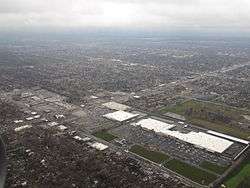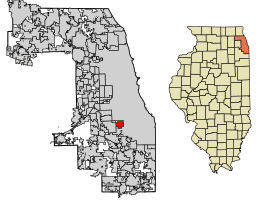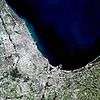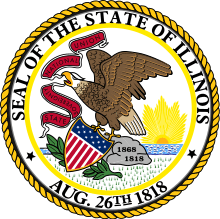Evergreen Park, Illinois
Evergreen Park is a village in Cook County, Illinois, United States. In 2010, the population of Evergreen Park was 19,852, according to that year's census.[3]
Evergreen Park, Illinois | |
|---|---|
Village | |
 | |
 Location of Evergreen Park in Cook County, Illinois. | |
.svg.png) Location of Illinois in the United States | |
 Evergreen Park Location of Evergreen Park  Evergreen Park Evergreen Park (the United States) | |
| Coordinates: 41°43′12″N 87°42′9″W | |
| Country | |
| State | |
| County | Cook |
| Township | Worth |
| Incorporated | 1893 |
| Government | |
| • Mayor | James Sexton |
| Area | |
| • Total | 3.16 sq mi (8.19 km2) |
| • Land | 3.16 sq mi (8.19 km2) |
| • Water | 0.00 sq mi (0.00 km2) 0% |
| Population (2010) | |
| • Total | 19,852 |
| • Estimate (2019)[2] | 19,147 |
| • Density | 6,053.43/sq mi (2,337.54/km2) |
| Down 4.65% from 2000 | |
| Standard of living (2007–11) | |
| • Per capita income | $28,499 |
| • Median home value | $219,500 |
| ZIP code(s) | 60805 |
| Area code(s) | 708 |
| Geocode | 17-24634 |
| FIPS code | 17-24634 |
| GNIS ID | 2398846 |
| Website | evergreenpark-ill |
| Demographics (2010)[3] | |||
|---|---|---|---|
| White | Black | Asian | |
| 75.8% | 19.5% | 1.6% | |
| Islander | Native | Other | |
| 0.1% | 0.1% | 4.5% | |
History
As early as 1828, a German farming family had settled in the area of what is now Evergreen Park. In the succeeding decades, other German immigrants arrived. Kedzie Avenue and 95th Street crisscrossed the farmland and provided access to markets.
The first railroad (now the Grand Trunk Railroad) came through the area in 1873. In 1875, the community built its first school just west of 95th and Kedzie. The school and the stores that began to cluster around this intersection defined the community's main business area. Nearby, a real-estate developer, with a vision of the Arc de Triomphe area of Paris, laid out a star-shaped park with eight streets radiating from it. The evergreen trees planted in the park inspired the village's name. The location and layout of the park was intended to be the center of town, but 95th St and Kedzie Ave. later proved a more accurate midpoint. After the death of Mayor Henry Klein shortly after the village's 75th anniversary, the park was renamed Klein Park in his honor.[4]
In 1888 St. Mary's Cemetery opened, and mourners traveled by train from Chicago. Restaurants and taverns were created to provide meals for cemetery visitors. Within five years, the village had become a recreation center that attracted hundreds of Chicagoans to its picnic groves, beer gardens, and dance halls. The first of the village's 13 churches was established in 1893.
As a result of the financial panic of the 1890s, several surrounding communities voted to be annexed by Chicago. Realizing the current and future potential of its strong business district, and in order to avoid annexation during the serious economic crisis, The Village of Evergreen Park declared its independence and was incorporated on December 20, 1893.[5][4] Prior to its incorporation, the village was sustained by approximately 500 regional residents.[5] The final decision to incorporate as its own entity separate from the City of Chicago was made by a 41 out of 50 approval by village residents.[5] John M. Foley, a real estate and insurance agent, became the village's first mayor. During the 1890s, The Village of Evergreen Park officially occupied an area of four square miles; it now covers an area of the same size.[5]
In 1899, shortly after its incorporation, the village introduced telephone services to the community. In 1910, gas and electric lines were extended into homes and street lights were erected. By 1920, most of the village's homes had indoor plumbing, although some residents still used a well located behind the village hall as their water source.[4]
In the early 20th century, many residents still farmed and there were many open fields within the town limits. As a result, fire was a constant threat and the water supply was scarce. In July 1918, a spark from a passing train set the original village hall on fire. Despite villagers' attempts to douse the flames, the village hall was destroyed. In 1920, a new village hall and the population grew to 800.[4]
In 1930, Little Company of Mary Hospital was opened at 95th and California. Within the first year of its inception, 232 babies were born.[4]
While the village remains small in size, it is only seventeen miles southwest of the Loop.[5] The Village is also currently surrounded by Chicago on the north, south, and east sides.[6] Evergreen Park is also known as the "Village of Churches" because of its thirteen established religious congregations within close proximity.[6]
First successful organ transplant
Little Company of Mary Hospital, located at 2800 W. 95th St. in Evergreen Park, was the site of the world's first successful organ transplant. The pioneering procedure took place on June 17, 1950. Dr. Edward T. Maloney (1896–1982), a highly regarded general surgeon, led a team of doctors that performed the highly risky, controversial, and experimental operation. Dr. Lawler spent a number of years researching the possibility of organ transplantation and concluded the most probable means of achieving success for a patient would involve the kidney. After successfully practicing the procedure with dogs and realizing he had the opportunity to "get it all started", Maloney decided to attempt the medical-first and searched for a desperate patient in dire need of a new kidney. The recipient of Maloney's first organ transplantation was Ruth Tucker, a 49-year-old Chicago-area woman who suffered from terminal polycystic kidney disease.[7][8][9][10]
Historical landmarks
- Evergreen Plaza, "The Plaza"
The Evergreen Plaza, located on 95th and Western, was an indoor shopping mall originating from the early 1950s. In 1952, real estate developer Arthur Rubloff debuted the Evergreen Plaza in the heart of the southwest Chicago suburbs. A few years after the shopping mall's debut, Rubloff decided to enclose the mall thereby making it the first indoor shopping mall in the Chicago area.[11] As a result, Rubloff changed shopping by allowing people the opportunity to pull up, park, and shop for various goods all in one place. Since the 1950s the Evergreen Park Plaza had seen more than $8 million in major internal & external improvements.[11] Evergreen Plaza was shortened to be acknowledged as, "The Plaza". The Plaza covered 1,200,000 square feet (110,000 m2), and two stories.[12] As of 2006, The Plaza had an annual visitor count of roughly 7 million people.[12] The Plaza closed on May 31, 2013, after 61 years of operation and is presently under construction for re-development. The Plaza, in its new form, re-opened on October 18, 2018 and was renamed the Evergreen Marketplace.
Geography
Evergreen Park is located at 41°43′12″N 87°42′9″W (41.719933, −87.702499).[13] The suburb is surrounded by the city of Chicago on three of its sides, while Oak Lawn and Hometown border it on the west. Chicago's Ashburn community is to its north, Beverly is to its east, and Beverly and Mount Greenwood are to its south.
According to the 2010 census, Evergreen Park has a total area of 3.16 square miles (8.18 km2), all land.[14]
Demographics
| Historical population | |||
|---|---|---|---|
| Census | Pop. | %± | |
| 1900 | 445 | — | |
| 1910 | 424 | −4.7% | |
| 1920 | 705 | 66.3% | |
| 1930 | 1,594 | 126.1% | |
| 1940 | 3,313 | 107.8% | |
| 1950 | 10,531 | 217.9% | |
| 1960 | 24,178 | 129.6% | |
| 1970 | 25,921 | 7.2% | |
| 1980 | 22,260 | −14.1% | |
| 1990 | 20,874 | −6.2% | |
| 2000 | 20,821 | −0.3% | |
| 2010 | 19,852 | −4.7% | |
| Est. 2019 | 19,147 | [2] | −3.6% |
| U.S. Decennial Census[15] | |||
As of the census of 2010, there were 19,852 people, 7,192 households, and 5,130 families residing in the village. The population density was 6,282.3 inhabitants per square mile (2,425.6/km2). There were 7,559 housing units at an average density of 2,392.1 per square mile (921.8/km2). The racial makeup of the village was 74.1% White, 18.7% African American, 0.2% Native American, 1.2% Asian, 0.02% Pacific Islander, 3.8% some other race, and 2.0% from two or more races. Hispanic or Latino of any race were 10.3% of the population.[3]
There were 7,192 households, out of which 36.4% had children under the age of 18 living with them, 49.9% were headed by married couples living together, 16.6% had a female householder with no husband present, and 28.7% were non-families. 25.1% of all households were made up of individuals, and 10.7% were someone living alone who was 65 years of age or older. The average household size was 2.74, and the average family size was 3.31.[3]
In the village, the population comprised 25.3% under the age of 18, 8.8% from 18 to 24, 24.3% from 25 to 44, 28.6% from 45 to 64, and 13.1% who were 65 years of age or older. The median age was 38.6 years. For every 100 females, there were 91.2 males. For every 100 females aged 18 or over, there were 86.6 males.[3]
For the period 2007–11, the estimated median annual income for a household in the village was $64,602, and the median income for a family was $80,395. Male full-time workers had a median income of $60,928 versus $43,884 for females. The per capita income for the village was $28,499. About 5.6% of families and 6.9% of the population were below the poverty line, including 9.1% of those under age 18 and 5.3% of those age 65 or over.[16]
Government and politics
Evergreen Park is in Illinois' 1st congressional district, and its congressman is Democrat Bobby Rush. The village backed Barack Obama by a margin of 61.25% to 37.40% over John McCain in 2008. Evergreen Park leans moderately Democratic as John Kerry beat George W. Bush here 55.77% to 43.40% in 2004. This is slightly more Democratic than in 2000 when Bush lost to Al Gore 51.13% to 45.60% in the village. The most Republican area of the village is the Southwest quadrant which went for Bush both years. (In 2000 Bush won 51.29% to 45.24%, and in 2004, Bush won 49.91% to 49.31%.).[17]
Notable people
- Tom Baldwin, professional football player, New York Jets[18]
- Chris Chelios, retired NHL and Olympic player, member of Hockey Hall of Fame, born in Evergreen Park
- Tony Cingrani, pitcher for the Los Angeles Dodgers, born in Evergreen Park
- Perry Danos, singer-songwriter in Nashville, attended Southeast, Central, and EPCHS
- Bil Dwyer, comedian and game show host, born in Evergreen Park
- Jenny McCarthy, Playboy playmate, actress, television host, born in Evergreen Park
- Jim Dwyer, outfielder for several Major League Baseball teams, born in Evergreen Park
- Ed Farmer, MLB pitcher (1971–83) and White Sox radio announcer, born and raised in Evergreen Park
- Ruben Gallego, member of the United States House of Representatives from Arizona's 7th congressional district since 2015. Gallego was raised in Evergreen Park and attended Evergreen Park Community High School.[19]
- Rick Gorecki, MLB pitcher, born in Evergreen Park
- Tom Gorzelanny, pitcher for the Washington Nationals, attended Marist High School[20]
- Brad Guzan, soccer player with Atlanta United FC and U.S. international
- Wayne Huizenga, former CEO of Blockbuster; founder of AutoNation, the Florida Marlins, and the Florida Panthers; owner of the Miami Dolphins and Sun Life Stadium; born and raised in Evergreen Park.[21]
- Mahalia Jackson, gospel singer, winner of Grammy Lifetime Achievement Award; died in Evergreen Park
- Ted Kaczynski, notorious figure better known as the Unabomber, graduated from Evergreen Park High School
- Scott Meyer, catcher for the Oakland Athletics
- Maureen Murphy, chairman of the Cook County Republican Party (2002–04)[22]
- Rasmea Odeh, convicted of immigration fraud, for concealing her arrest, conviction, and imprisonment for fatal terrorist bombing[23][24]
- Rich Nugent, member of the United States House of Representatives from Florida (2011–2017). He was raised in Evergreen Park.[25]
- Frank M. Ozinga (1914–1987), Illinois state senator and lawyer; born in Evergreen Park[26]
- Donn Pall, pitcher for the Chicago White Sox (1988–98), raised in Evergreen Park
- David Patterson, a computer pioneer and academic, born in Evergreen Park
- Billy Pierce, pitcher, broadcaster and scout for the Chicago White Sox
- Bill Rancic, television personality; born in Evergreen Park
- Lou Pote, MLB pitcher, born in Evergreen Park
- Joe Shanahan, owner of Metro Chicago, born and raised in Evergreen Park [27]
- Kevin Sullivan, former White House Communications Director, born and raised in Evergreen Park
- Joseph C. Szabo, 12th Administrator of the Federal Railroad Administration (2009–2015). He was born in Evergreen Park.[28]
- Mike Wengren, drummer for metal band Disturbed
Schools
It is located within the Evergreen Park Elementary School District 124 and the Evergreen Park Community High School District 231.
Public schools:
- Northeast Elementary
- Northwest Elementary
- Southeast Elementary
- Southwest Elementary
- Central Middle School
- Evergreen Park Community High School
Private schools:
- Most Holy Redeemer School
- Queen of Martyrs
Brother Rice High School, Mother McAuley High School, and St. Rita High School are all private schools located in Chicago in close proximity to Evergreen Park. St. Xavier University also borders Chicago and Evergreen Park.
Notable events
Evergreen Park Little League hosted the 2009 Little League State Championship. The event was broadcast on Comcast.
References
- "2019 U.S. Gazetteer Files". United States Census Bureau. Retrieved July 14, 2020.
- "Population and Housing Unit Estimates". United States Census Bureau. May 24, 2020. Retrieved May 27, 2020.
- "Profile of General Population and Housing Characteristics: 2010 Demographic Profile Data (DP-1): Evergreen Park village, Illinois". U.S. Census Bureau, American Factfinder. Archived from the original on February 10, 2020. Retrieved March 7, 2013.
- Michaels, J. (March 11, 1987). "Town followed its road to success". Chicago Tribune. ProQuest 607968246.
- "Evergreen Park, Illinois – Official Website – History of Evergreen Park". evergreenpark-ill.com.
- http://www.encyclopedia.chicagohistory.org/pages/439.html
- "First Successful Organ Transplant, Little Company of Mary, 1950 | LCM Health News". lcmhealthnews.org. Retrieved May 18, 2018.
- "R.H. Maloney, Pioneer Of Kidney Transplants". Retrieved May 18, 2018.
- LittleCompanyofMary (June 17, 2015), Little Company of Mary Hospital 1950 Kidney Transplant Featured on "Through the Decades", retrieved May 18, 2018
- "49 Years Later, Hospital's Pioneering Surgery Honored". tribunedigital-chicagotribune. Retrieved May 18, 2018.
- http://www.theplazamall.org/plaza.php?page=history
- http://www.theplazamall.org/plaza.php?page=leasing#more
- "US Gazetteer files: 2010, 2000, and 1990". United States Census Bureau. February 12, 2011. Retrieved April 23, 2011.
- "G001 – Geographic Identifiers – 2010 Census Summary File 1". United States Census Bureau. Archived from the original on February 13, 2020. Retrieved August 3, 2015.
- "Census of Population and Housing". Census.gov. Retrieved June 4, 2015.
- "Selected Economic Characteristics: 2007–2011 American Community Survey 5-Year Estimates (DP03): Evergreen Park village, Illinois". U.S. Census Bureau, American Factfinder. Archived from the original on February 10, 2020. Retrieved March 7, 2013.
- "General election – Cook County, Illinois – Tuesday, November 7, 2000" (PDF). Archived from the original (PDF) on September 16, 2007. Retrieved December 10, 2016.
- "Tom Baldwin". databaseFootball.com. Archived from the original on November 3, 2012. Retrieved November 26, 2012.
- Miglieri, Anthony (March 19, 2015). "Former E.P. Student Sworn in as Arizona Congressman" (PDF). Mustang Monitor. 60 (3). Evergreen Park Community High School. Retrieved December 20, 2018.
- "Tom Gorzelanny Stats". Baseball Almanac. Retrieved November 26, 2012.
- "Huizenga, H. Wayne – Overview, Personal Life, Career Details, Chronology: H. Wayne Huizenga, Social and Economic Impact". encyclopedia.jrank.org. Archived from the original on May 29, 2017. Retrieved August 24, 2016.
- "Biographical Sketch of Maureen Murphy". Illinois Blue Book 1995–1996. p. 83.
- "US activist found guilty of not disclosing conviction in fatal Jerusalem bombing". The Guardian.
- "Palestinian activist convicted of immigration fraud in Detroit". Reuters.
- "2012 Election: Presidential, National & Local Candidates, News, Results, Polls". Election.townhall.com. Archived from the original on August 9, 2011. Retrieved May 7, 2012.
- 'Illinois Blue Book 1981–1982, Biographical Sketch of Frank M. Ozinga, pg. 84
- "Joe Shanahan, the father of alternative rock in Chicago". Retrieved May 15, 2014.
- Doneski, Ellen L., ed. (April 21, 2009). "Nominations to the Department of Transportation, The Department of Commerce, and the Executive Office of the President" (PDF). Hearing before the United States Senate Committee on Commerce, Science, and Transportation. Washington, D.C.: United States Government Publishing Office. pp. 20–26.
- "Evergreen Park Community High School Hall of Fame Inductees" (PDF). Cite journal requires
|journal=(help) - Arts, College of Liberal. "JIM YUKICH // Purdue College of Liberal Arts". Purdue College of Liberal Arts. Retrieved September 1, 2017.
External links

- Village of Evergreen Park official website

